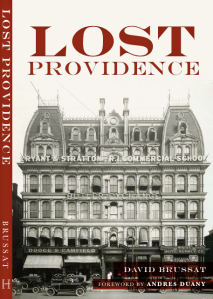
Statehouse of Connecticut in Hartford. (Connecticut Architecture)
Next Wednesday I’ll be visiting Waterbury, Conn., for the first time in a great many years, and even then I did not visit but passed through. For a New Englander (by choice, not by birth) I have relatively little experience of the Nutmeg State, most of it whizzing by along the coast from the windows of Amtrak. Its countryside has always charmed this urbanist more than its big cities. Its smaller cities, Waterbury, Danbury, Bristol, New Britain, and towns such as Putnam, Pomfret and others along Route 44 and roads beyond I am more familiar with from trips long ago to see relatives in Springfield, Mass. My editor at the Providence Journal, Bob Whitcomb, once dragged me to Stonington, across the Pawcatuck from Westerly. He figured he’d surprise me with its beauty – and he did. It was lovely. I was unfamiliar with that corner of Connecticut, too.
I am just as unfamiliar with a book whose author, Christopher Wigren, will lecture on his state’s trove of architecture at a lecture in Waterbury City Hall. The book, Connecticut Architecture: Stories of 100 Places, newly published by Wesleyan University Press, was a project of his employer, the Connecticut Trust for Historic Preservation, where he is deputy director. His free talk, at 6 p.m. next Wednesday, Jan. 30, is sponsored by the New England chapter of the Institute of Classical Architecture & Art as a project of its membership committee; our Michael Tyrrell made the event happen.
The book and its author form a good reason to attend, but the location in City Hall is of no small curiosity as well. The firm of DeCarol & Doll, of Meriden, Conn., won a Bulfinch award for its restoration of Waterbury City Hall in 2011, the second year of the annual awards program sponsored by the ICAA’s New England chapter. The HQ of the Brass City was designed by the celebrated architect Cass Gilbert and completed in 1915. Check it out!
“Place Yourself,” a review of the book by Kathy Leonard Czepiel for The Daily Nutmeg, in New Haven, gives an excellent account of the book, which, with 210 photos, widely sourced, 173 of them in color, is not just a picture book for a coffee table but an erudite history of the architectural progress of the state. Czepiel thinks highly of Wigren’s treatment of it, writing:
This history is liberally accompanied by photographs and well worth a read on its own, but the book’s greatest appeal is the 12 sections that follow, highlighting different facets of Connecticut architecture: landscapes, “materials and technologies,” homes, farms, factories, towns and cities, transportation, public buildings and so on. As Wigren emphasizes in his preface, Connecticut Architecture doesn’t offer a list of greatest hits. Rather, it uses some of our most interesting, iconic or illustrative places to tell the tale of a state rich in architectural variety and stories.
A very small number of the 100 places Wigren describes in text and photos are modernist, and, to judge by Czepiel’s review, he is straightforward about it. Exemplifying what Wigren calls urban renewal’s “difficult legacy,” Czepiel describes a modernist church imposed upon one of New Haven’s targeted neighborhoods:
What remains intact of the renewal plan for Dixwell is the Dixwell Avenue Congregational United Church of Christ, designed in 1968 by New Canaan architect John M. Johansen, “who at the time was experimenting with dramatic, irregular forms in place of the simplicity of earlier Modernist designs.” The congregation itself, we’re told in the book’s introduction, had “been considering a Colonial Revival edifice before the Redevelopment Agency assigned the Modernist architect” to it.
Typical. Without knocking the splendid architecture featured in the book, it may be fair to say that Connecticut’s cities demonstrate how lucky it is that the state’s redevelopment bureaucracy did not try to impose urban renewal on the countryside. In my admittedly limited experience, rural Connecticut has been treated better than urban Connecticut. That is easy to see, and the reason for the disparity no doubt has to do with the relative power in state government of people who live in cities versus people who live in bucolic environments – a topic miles above my pay grade and perhaps Wigren’s as well. As for the suburbs betwixt town and country, I’m sure those of the Nutmeg State, as in most places, run the gamut. I look forward to learning how Chris Wigren explains all this in his book – and/or in his lecture.

Waterbury City Hall (1915), designed by Cass Gilbert. (Cass Gilbert Society)



Reblogged this on Place Travel and commented:
Bulfinch Award, Bulfinch Awards, Cathy Leonard Czepiel, Christopher Wigrem, Connecticut, Connecticut Architecture, DeCarol & Doll, ICAA, Michael Tyrrell, The Daily Nutmeg, Urban Planning, Waterbury City Hall, Waterbury CT
LikeLike